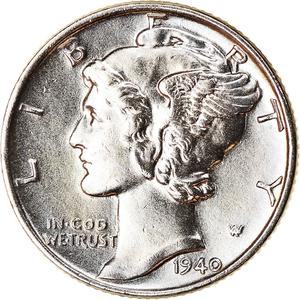Information about effigy: Liberty, Mercury Head

This portrait of Miss Liberty was developed for the so-called "Mercury dime" - a ten-cent coin struck for circulation by the United States Mint from late 1916 to 1945. Designed by Adolph Weinman and also referred to as the Winged Liberty Head dime, it gained its common name because of the obverse depiction of a young Liberty - identifiable by her winged Phrygian cap - was confused with the Roman god Mercury. By 1916, the dime, quarter, and half dollar designed by Mint Chief Engraver Charles E. Barber had been struck for 25 years, and could be replaced by the Treasury, of which the Mint is a part, without Congressional authorisation. Mint officials were under the misapprehension that the designs had to be changed, and held a competition among three sculptors, in which Barber, who had been in his position for 36 years, also took part. Weinman's designs for the dime and half dollar were selected. Weinman's portrait depicts Miss Liberty with a wreath of tight curls, wearing a traditional pileus, or Liberty cap; the depiction of the pileus as a winged cap has provoked comparisons with Roman Republic denarii. Weinman wrote that he considered the winged cap to be a symbol of "liberty of thought". The coin continued to be minted until 1945, when the Treasury ordered that a new design, featuring recently deceased president Franklin Roosevelt, take its place. The Mercury dime was minted again but in gold for its centenary in 2016. The design is now used on the obverse of the American Palladium Eagle. |

Liberty Head (Mercury) on a 1940 Dime United States / One Dime 1940 Mercury The "Mercury" type of depiction of Miss Liberty was created for the one dime denomination, issued in 90% silver between 1916 and 1945. |
|
| Year | 1916 |
|---|---|
| Country | United States |
| Image | Details |
|---|---|
 Liberty, Portrait Liberty, PortraitFrom 1793 |

